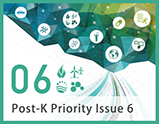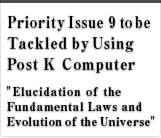Purpose and significance
The first purpose of this project is to explore the unsolved issues in microscopic physics by larger-scale numerical computation. Specifically, the issues are to accurately determine the baryon-baryon interactions, nuclear structure and many-body reactions between nuclei, and the equation of state for high-density nuclear matter. The second purpose is to explore explosive astrophysical phenomena, in particular, core-collapse supernova explosion and binary neutron star mergers, incorporating the microscopically physical knowledge derived by the large-scale numerical computation. The third purpose it to explore the origin of heavy elements such as gold and silver in the universe. For this purpose, we will combine the knowledge obtained by the microscopic and astrophysical simulations performed in this project.
These computational results will be also used as the theoretical predictions for nuclear physics and astrophysics, which are necessary for current large-scale experimental and observational facilities (e.g., J-PARC, RIBF, Subaru Telescope), and large-scale telescope projects that are scheduled to start operating in earnest in this decade (such as KAGRA and TMT). These theoretical predictions will deliver the maximum potential from these experimental and observational projects. Furthermore, we will calculate many-body reactions involving nuclei in order to contribute to peripheral fields such as acquiring fundamental data for nuclear conversion technology that is essential for nuclear waste processing.
Member
Chief
Shibata Masaru: Professor, Yukawa Institute for Theoretical Physics, Kyoto University
QCD group
Doi Takumi: Senior Research Scientist, RIKEN Nishina Center for Accelerator-Based Science
Hatsuda Tetsuo: Program Director, RIKEN Interdisciplinary Theoretical and Mathematical Sciences Program (iTHEMS)
Gongyo Shinya: Special Postdoctoral Researcher, RIKEN Nishina Center for Accelerator-Based Science
Doi Takahiro: Special Postdoctoral Researcher, RIKEN Nishina Center for Accelerator-Based Science
Iritani Takumi: Postdoctoral Researcher, RIKEN Nishina Center for Accelerator-Based Science
Aoki Sinya: Professor, Yukawa Institute for Theoretical Physics, Kyoto University
Sasaki Kenji: Assistant Professor, Yukawa Institute for Theoretical Physics, Kyoto University
Aoyama Tatsumi: Researcher, Yukawa Institute for Theoretical Physics, Kyoto University
Ishii Noriyoshi: Associate Professor, Research Center for Nuclear Physics, Osaka University
Ikeda Yoichi: Assistant Professor, Research Center for Nuclear Physics, Osaka University
Nemura Hidekatsu: Assistant Research Staff, Research Center for Nuclear Physics, Osaka University
Murano Keiko: Assistant Research Staff, Research Center for Nuclear Physics, Osaka University
Ishikawa Ken-ichi: Associate Professor, Graduate School of Science, Hiroshima University
Kanamori Issaku: Researcher, Graduate School of Science, Hiroshima University
Inoue Takashi: Associate Professor, College of Bioresource Sciences, Nihon University
Nuclear Physics group
Shimizu Noritaka: Project Associate Professor, School of Science, The University of Tokyo
Otsuka Takaharu: Senior Visiting Scientist, RIKEN
Abe Takashi: Assistant Professor, School of Science, The University of Tokyo
Ichikawa Takatoshi: Project Assistant Professor, School of Science, The University of Tokyo
Togashi Tomoaki: Project Assistant Professor, School of Science, The University of Tokyo
Tsunoda Naofumi: Project Assistant Professor, School of Science, The University of Tokyo
Tsunoda Yusuke: Researcher, School of Science, The University of Tokyo
Javier Menendez: Researcher, School of Science, The University of Tokyo
Miyagi Takayuki: Researcher, School of Science, The University of Tokyo
Utsuno Yutaka: Principal Researcher, The Japan Atomic Energy Agency
Honma Michio: Professor, Division of Computer Science, The University of Aizu
Yoshida Tooru: Chief, Research Organization for Information Science and Technology
Astrophysics group
Shibata Masaru: Professor, Yukawa Institute for Theoretical Physics, Kyoto University
Suwa Yudai: Associate Professor, Yukawa Institute for Theoretical Physics, Kyoto University
Kiuchi Kenta: Associate Professor, The Center for Gravitational Physics, Yukawa Institute for Theoretical Physics, Kyoto University
Nishimura Nobuya: Assistant Professor, Yukawa Institute for Theoretical Physics, Kyoto University
Suzuki Akihiro: Assistant Professor, Yukawa Institute for Theoretical Physics, Kyoto University
Iwakami Wakana: Research Fellow, Faculty of Science and Engineering, Waseda University
Okawa Hirotada: Research Fellow, Faculty of Science and Engineering, Waseda University
Yamada Shoichi: Professor, Faculty of Science and Engineering, Waseda University
Sumiyoshi Kousuke: Professor, National Institute of Technology, Numazu College
Kotake Kei: Associate Professor, Faculty of Science, Fukuoka University
Nakamura Ko: Assistant Professor, Faculty of Science, Fukuoka University
Sekiguchi Yu-ichiro: Lecturer, Faculty of Science, Toho University
Takiwaki Tomoya: Assistant Professor, National Astronomical Observatory of Japan
Nagakura Hiroki: Postdoctoral Scholar, California Institute of Technology
Future outlook: 10 years later and beyond
- We will determine the odd-parity nuclear force, hyperon force, spin-orbit force, and three-baryon force. These results will be used for determining the neutron-star equation of state that has been the puzzle in the past two decades.
- We will determine the nuclear structure and reaction data needed for calculations concerning heavy element synthesis and nuclear conversion technology, and apply it to develop such technology.
- We will clarify a variety of phenomena associated with supernova explosions that have been extensively observed in recent years. Our numerical-simulation results will give an invaluable prediction for the future observation of the neutron star mergers by gravitational-wave detectors and electromagnetic telescopes.





























